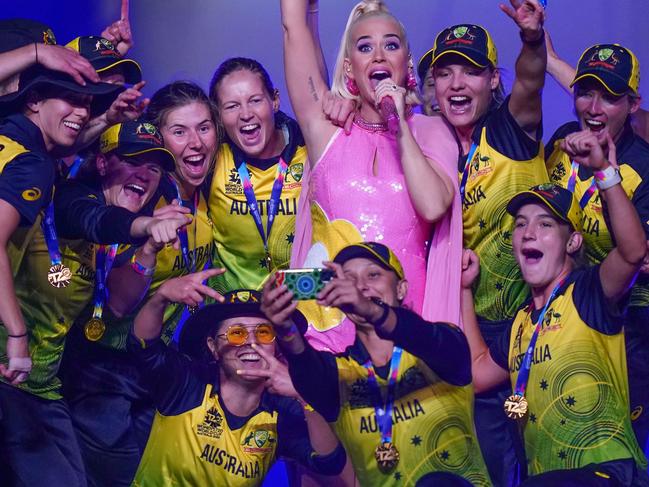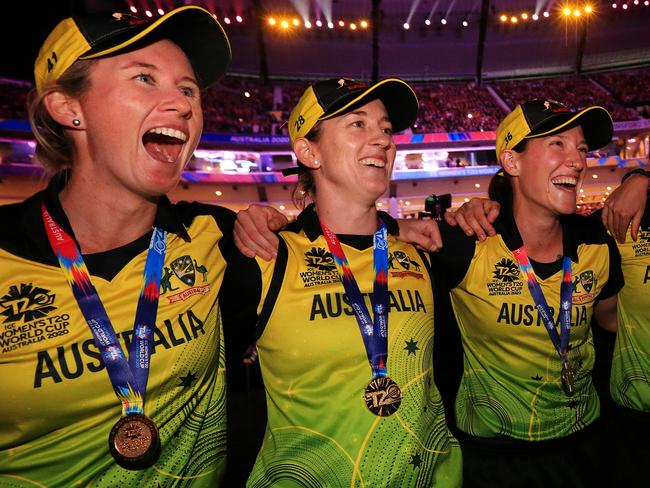From record crowd to a series on the rocks – how Australia’s women’s cricket team is dealing with its future during the pandemic
The sight of more than 86,000 fans flocking to the MCG to watch the Women’s T20 World Cup will be an enduring memory of pre-COVID sport. But will that moment in time be enough to ensure its survival?
Cricket
Don't miss out on the headlines from Cricket. Followed categories will be added to My News.
Such is the time-bending effect of the coronavirus pandemic, it’s hard to believe it is barely six months since some 86,174 cricket-lovers crammed into the MCG to witness one of the greatest nights ever in the women’s game.
When Australia defeated India by 85 runs in the final of the T20 World Cup, the crowd set a new Australian record for a women’s sporting event.
A week later, the world fell in.
The MCG has fallen silent for the foreseeable future.
Sport, like most facets of life, has been torn apart by COVID.
For the Australian Women’s Cricket Team the upheaval feels particularly pronounced, given the sharp and sudden fall from that immense high in March.
Kayo is your ticket to the best sport streaming Live & On-Demand. New to Kayo? Get your 14-day free trial & start streaming instantly >

The concern now is that the momentum gained from that tournament and other successes risks being lost under the pressures of the ‘new normal’.
That the difficulties and financial burdens associated with rebooting sport will see women’s sport fall back down the list of priorities.
Two successful men’s Test series have already been played in COVID-ravaged England. Australia’s men fly out there this weekend.
Planned tours to the UK by the South African and Indian women, however, have been postponed.
The decision by the BCCI, India’s cricket board, to schedule a women’s IPL tournament at the same time as Australia’s WBBL was highly criticised as a loss for women cricketers, limiting opportunities for the world’s best to compete in multiple tournaments.
But the most significant development came in early August when the ICC postponed the Women’s 50-over World Cup, originally scheduled for New Zealand in February 2021, until 2022.
“As athletes when things are in the calendar, we’re always looking forward, so there’s always an element of disappointment when something isn’t where you’ve prepared for it to be,” says Australian opener Beth Mooney.
“It’s a disappointing time given the momentum we gained last season, but we’ve now got an extra year to prepare and make sure we have the team to go out on the park and win that trophy back.”
That understanding is shared by Mooney’s coach, Matthew Mott, conscious that the advancement of the women’s game is not the preserve of Australia alone.

“We’re mindful of having a level playing field and some of those other countries, for example Pakistan, they haven’t been able to get out of their houses for the last couple of months so asking them to go through a qualifying tournament without even seeing a cricket ball for that long is pretty unfair,” Mott says.
“We’ve got to take a world view on this and if you want a World Cup, you need everyone to have an equal chance of competing and winning … it feels a little bit like Christmas has been put back, but there are so many things are going on in this world that you need some perspective.”
Despite the challenges, optimism persists.
An 18-player squad was this week announced to host New Zealand next month. For now that series remains on.
“We have an amazing opportunity to be the first cricket team back at people’s eye lines in Australia, and that would be huge coming after the World Cup, but … the bio security measures (for the series) are going to be an exorbitant cost, and so everything must be factored in,” says Mott.

“The fact that we’re still talking about this series (that it hasn’t been cancelled), shows how highly Cricket Australia values the women’s game and how important it is.”
For now Australia’s women are battling to retain focus and fitness while spread across country, at home in their respective states.
Australia’s worst hit region is also home to the largest contingent of internationals. Players like captain Meg Lanning have been granted special exemptions to travel outside of their Victorian suburbs and train at Junction Oval three times a week.
“When the (Stage 4) restrictions came in there was a lot of unknown it looked pretty grim,” admits Lanning, “but we can still train, which is what I enjoy doing, can still see some people throughout the week for which we’re really lucky and still got a job as well, which a lot of people out there don’t,” Lanning says.

“It can’t be easy when you’re at home and you’ve got a lot of time to think about all the things you can’t do, but at the end of the day, we’re in a very lucky position.
“But that New Zealand series – that’s been a bit of a carrot the whole way through to try, when we are training, to work towards that.”
The team stay connected as a team through Zoom meetings and WhatsApp groups.
It is an imperfect set up. But one players like South Australian bowler Megan Schutt hope can bridge the gap to a time when growth rather than survival becomes the mantra again.
“I think we’ve built enough momentum and respect now so that when the sport starts up again as a whole when normality returns, we can get back to what it was and talking about women’s cricket again in the same way we were before it ended,” she says.
MORE CRICKET NEWS
Originally published as From record crowd to a series on the rocks – how Australia’s women’s cricket team is dealing with its future during the pandemic


